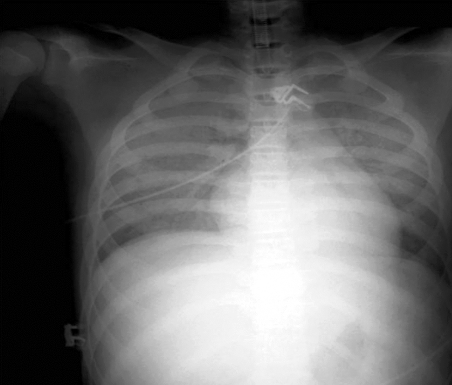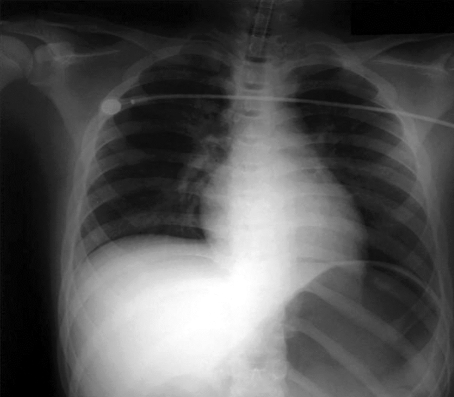Abstract
Topical phenylephrine, an agent used to facilitate nasotracheal intubation and prevent nasal mucosal bleeding, can cause severe hypertension in some patients, secondary to its stimulation of alpha-adrenergic receptors. Moreover, a high incidence of pulmonary edema is found in patients whose phenylephrine administration is followed by treatment with beta-blocking agents. We report a case of acute pulmonary edema in a pediatric patient who developed severe hypertension after the inadvertent administration of a large dose of topical nasal phenylephrine, followed by beta-adrenergic antagonists (esmolol).
Keywords: Phenylephrine, beta-adrenergic antagonist, pulmonary edema
INTRODUCTION
Nasotracheal intubation is routinely performed in maxillofacial surgery to optimize the surgical field. Phenylephrine is applied to the nasal mucosa before nasotracheal intubation because its vasoconstrictive properties facilitate insertion of the tube. Phenylephrine is predominately an alpha-adrenergic agonist. Therefore, if significant systemic absorption occurs following topical administration, adverse cardiopulmonary consequences, such as hypertensive crisis, reflex bradycardia and ventricular arrhythmias, may occur. Pulmonary edema is more likely to develop when systemic absorption of topical phenylephrine is followed by beta-adrenergic antagonists in an attempt to control phenylephrine-induced hypertension.1-3
We report a case of acute pulmonary edema following administration of a 1.5 ml dose of 0.5% phenylephrine during the induction of general anesthesia in a pediatric patient undergoing dentigerous cyst resection.
CASE REPORT
A 13-year-old boy was admitted for dentigerous cyst resection. On admission, his physical examination appeared normal and there was no evidence of pulmonary or cardiac disease. The patient had no significant past medical or family history. His weight and height were 76 kg and 1.65 meters, respectively.
No premedication was administered. Monitors (ECG, blood pressure cuff and pulse oximetry) were applied for general anesthesia. Preoperative vital signs were as follows: heart rate 117 beats min-1, BP 136/73 mmHg and SpO2 98%. After the administration of propofol (120 mg) and vecuronium (9 mg), anesthesia was induced with additional sevoflurane (up to 4 vol%) by mask in a mixture of oxygen and nitrous oxide (FiO2, 0.5). One minute later, 0.5% phenylephrine was sprayed into both nostrils, using a multiorificed cannula to ensure uniform distribution on the nasal mucosa. However, 1.5 ml of 0.5% phenylephrine was ad ministered instead of the intended dose of 0.5 ml. The patient was then given alfentanil (1 mg) and atropine sulfate (0.5 mg) to blunt the hemodynamic response to intubation. Two minutes after the phenylephrine intranasal spray administration, the patient's BP was 135/63 mmHg, and his heart rate reduced to 48 beats min-1.
Atropine sulfate (0.5 mg) was then administered to control bradycardia. Two minutes later, BP rose to 208/130 mmHg, and heart rate increased to 147 beats min-1. A 5 mg dose of esmolol, a beta-adrenergic antagonist, was then given, followed by an additional 5 mg dose. After three minutes, the monitors displayed a reduced SpO2. With a FiO2 of 0.5, SpO2 was reduced to 88%.
An endotracheal tube was inserted immediately, and manual ventilation with 100% oxygen was recommenced. At the time of nasotracheal intubation, BP was 142/91 mmHg and heart rate was 128 beats min-1. Auscultation revealed crepitations which were heard throughout the chest, and a blood-stained frothy fluid was aspirated from the trachea using a suction catheter via the endotracheal tube. A working diagnosis of pulmonary edema was entertained at that time, and intratracheal suctioning was performed several additional times. Turbutaline sulfate (0.5 mg) was injected subcutaneously, and furosemide (10 mg) was administered intravenously. Morphine (5 mg) and midazolam (3 mg) were also administered intravenously for sedation.
Five minutes after nasotracheal intubation, SpO2 increased to above 90%, and the intratracheal secretions decreased. Fifteen minutes post intubation, SpO2 had increased to 100% with a FiO2 of 1.0, BP was 117/67 mmHg and heart rate was 134 beats min-1. Following insertion of a Foley catheter, urine output was measured in the operating room. 300 ml of a blood-stained, frothy fluid was aspirated from the trachea, and urine output was 300 ml. The amount of intravenous normal saline administered was 450 ml over 3.5 hours, preoperatively. Although oxygen saturation had returned to the normal range at that point, surgery was postponed pending a consultation with specialists. The patient was transferred to the intensive care unit (ICU).
In the ICU, chest radiography, taken immediately after transfer, showed a diffuse homogenous alveolar infiltrate (Fig. 1). Ventilation was controlled using a ventilator in the synchronized intermittent mandatory ventilation (SIMV) mode, with a positive end expiratory pressure (PEEP) and FiO2 of 5 cm H2O and 0.5, respectively. Midazolam was administered for sedation in the ICU during ventilatory care. Six hours after being transferred to the ICU, these radiographic abnormalities had almost completely resolved (Fig. 2). Extubation was possible within thirty hours, and no further problems were encountered.
Fig. 1.
Chest radiograph taken immediately after transfer to the intensive care unit. Diffuse bilateral pulmonary infiltration is shown in both lung fields.
Fig. 2.
Chest radiograph taken 6 hours after admission to the intensive care unit showing near normal findings.
DISCUSSION
Acute onset pulmonary edema in the absence of airway obstruction is rarely encountered during the induction of general anesthesia. We describe a case of pulmonary edema in a pediatric patient following severe hypertension with tachycardia. We believe the most likely etiology to be an idiosyncratic response to medications, specifically topical phenylephrine followed by esmolol.
In otorhinolaryngology, the most commonly used topical vasoconstrictors are oxymetazoline (0.025-0.05%), cocaine (4-10%), and phenylephrine (0.25-1%).4 Phenylephrine is predominately an alpha-adrenergic agonist and significant systemic absorption can occur after topical administration. The intraocular use of large doses of phenylephrine has been reported to cause severe cardiovascular compromise and possibly pulmonary edema.5-7 Cardiopulmonary compromise may also occur after topical phenylephrine administration.1-3 Hypertension, secondary to alpha-adrenergic stimulation, is associated with increased peripheral vascular resistance (increased afterload) which can induce left ventricular failure. The resulting elevation in capillary pressure may trigger pulmonary edema.
Increased systemic vascular resistance increases left ventricular ejection impedance and end-diastolic volumes and pressures. In the face of increased peripheral vascular resistance, cardiac output may be further diminished, leading to cardiac congestion and left heart failure. The ability to increase heart rate and contractility are important compensatory mechanisms to preserve cardiac output under these circumstances. Although the majority of healthy patients tolerate mild degrees of myocardial depression without clinical sequelae, impairment of the hemodynamic compensatory mechanisms may result in pulmonary edema. Beta-adrenergic antagonists can impair these mechanisms.8
An initial dose of up to 0.5 mg (25 µg/kg) of phenylephrine has been suggested in the New York State Guidelines.1 This assumes 100% absorption of the administered phenylephrine dose. In our case, 1.5 ml of 0.5% phenylephrine, an amount that exceeds the recommended dose, was given inadvertently. Hypertension and tachycardia then occurred. Tachycardia was observed after atropine sulfate administration. Atropine sulfate can potentiate hypertension by inhibiting reflex bradycardia, leading to tachycardia.9
The hemodynamic parameters of the patient were BP of 208/130 mmHg and heart rate of 147 beats min-1. In a severe hypertensive state, pulmonary edema may occur more easily because esmolol will decrease BP and heart rate. Cardiovascular collapse occurs more frequently in patients who develop pulmonary edema and who have received labetalol, rather than esmolol.1 The shorter duration of beta-blocking activity of esmolol and the small dose administered in the present case may have prevented pulmonary edema from progressing to cardiovascular collapse.
To prevent future occurrences of the type of cardiopulmonary compromise witnessed in this case, it is important to recognize the possibility of abnormal absorption of topical alpha-agonists and to anticipate hypertensive events. If the hypertension begins to spontaneously resolve, no further medical therapy is warranted. However, if the increased pressure is severe or proves persistent, the administration of vasodilators and alpha-adrenergic antagonists are recommended.10,11 These agents are safer in this scenario than beta-adrenergic antagonists because they do not reduce the ability of a stressed myocardium to increase contractility and heart rate.
In conclusion, we describe a pediatric patient who experienced pulmonary edema and severe hypertension related to a systemic effect after the topical application of a large dose of phenylephrine and the subsequent administration of esmolol. The minimal amount of phenylephrine needed to achieve vasoconstriction should be administered to prevent nasal mucosal bleeding during nasotracheal intubation. Hemodynamic parameters should then be closely monitored and any necessary treatment should be given without delay.
References
- 1.Groudine SB, Hollinger I, Jones J, DeBouno BA The Phenylephrine Advisory Committee. New York State guidelines on the topical use of phenylephrine in the operating room. Anesthesiology. 2000;92:859–864. doi: 10.1097/00000542-200003000-00030. [DOI] [PubMed] [Google Scholar]
- 2.Kalyanaraman M, Carpenter RL, McGlew MJ, Guertin SR. Cardiopulmonary compromise after use of topical and submucosal alpha-agonists: Possible added complication by the use of beta-blocker therapy. Otolaryngol Head Neck Surg. 1997;117:56–61. doi: 10.1016/S0194-59989770207-9. [DOI] [PubMed] [Google Scholar]
- 3.Kademani D, Voiner JL, Quinn PD. Acute hypertensive crisis resulting in pulmonary edema and myocardial ischemia during orthognathic surgery. J Oral Maxillofac Surg. 2004;62:240–243. doi: 10.1016/j.joms.2003.08.011. [DOI] [PubMed] [Google Scholar]
- 4.Riegle EV, Gunter JB, Lusk RP, Muntz HR, Weiss KL. Comparison of vasoconstrictors for functional endoscopic sinus surgery in children. Laryngoscope. 1992;102:820–823. doi: 10.1288/00005537-199207000-00012. [DOI] [PubMed] [Google Scholar]
- 5.Van Der Spek AF, Hantler CB. Phenylephrine eyedrops and anesthesia. Anesthesiology. 1986;64:812–814. doi: 10.1097/00000542-198606000-00026. [DOI] [PubMed] [Google Scholar]
- 6.Baldwin FJ, Morley AP. Intraoperative pulmonary oedema in a child following systemic absorption of phenylephrine eyedrops. Br J Anaesth. 2002;88:440–442. doi: 10.1093/bja/88.3.440. [DOI] [PubMed] [Google Scholar]
- 7.Greher M, Harmann T, Winkler M, Zimpfer M, Crabnor CM. Hypertension and pulmonary edema associated with subconjunctival phenylephrine in a 2-month-old child during cataract extraction. Anesthesiology. 1998;88:1394–1396. doi: 10.1097/00000542-199805000-00032. [DOI] [PubMed] [Google Scholar]
- 8.Shanks RG. Clinical pharmacology of vasodilatory beta-blocking drugs. Am Heart J. 1991;121:1006–1011. doi: 10.1016/0002-8703(91)90612-l. [DOI] [PubMed] [Google Scholar]
- 9.Wray DW, Formes KJ, Weiss MS, O-Yurvati AH, Raven PB, Zhang R, et al. Vagal cardiac function and arterial blood pressure stability. Am J Physiol Heart Circ Physiol. 2001;281:H1870–H1880. doi: 10.1152/ajpheart.2001.281.5.H1870. [DOI] [PubMed] [Google Scholar]
- 10.Park JW, Wirtz JH, May E, Mertens S, Braun P, Heinzler R, et al. Enoximone therapy as pharmacological bridging to cardiac transplantation. Yonsei Med J. 1993;34:63–70. doi: 10.3349/ymj.1993.34.1.63. [DOI] [PubMed] [Google Scholar]
- 11.Nam YT, Kim JS, Park KW. Effect of hypotensive anesthesia with sodium nitroprusside or isoflurane on hemodynamic and metabolic changes. Yonsei Med J. 1992;33:320–325. doi: 10.3349/ymj.1992.33.4.320. [DOI] [PubMed] [Google Scholar]




